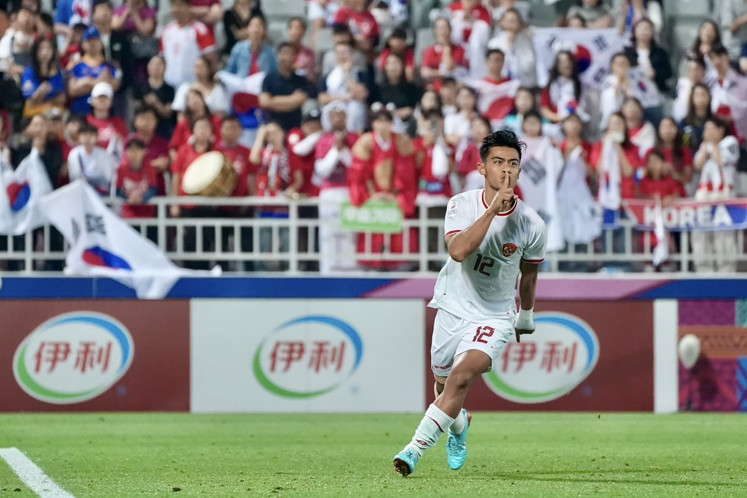Rubber, South Sumatra's new gold
Members of the Farmer Business Cooperative in Payaraman district, Ogan Ilir regency, South Sumatra, set out set rubber blocks in preparation for the weekly auction
Change Size

Members of the Farmer Business Cooperative in Payaraman district, Ogan Ilir regency, South Sumatra, set out set rubber blocks in preparation for the weekly auction. (JP/Khairul Saleh)
Spurred by rising prices and a strong export market, rubber has become the black gold of South Sumatra.
One of the province's rubber plantations, located in Payaraman district, Ogan Ilir regency, produces some 300 to 400 tons of the commodity each week.
The district's eight villages also host three farmer groups, each with 100 to 200 members.
With the price of rubber hovering around Rp 9,000 a kg, the farmers have been able to reap some Rp 2.8 billion in revenue per week.
Farmers typically produce two categories of rubber. Class A is the higher quality rubber, which has a water content of around 9 percent by weight per block, while class B rubber contains 11 percent by weight of water.
Rubber is traditionally preserved using alum or formic acid mixed with gum acid, or, more recently, with deorub, a liquid-smoke coagulant.
Most rubber growers in the region have formed groups or cooperatives to facilitate the promotion of their rubber auctions.
However, many farmers belong to the only Farmer Business Cooperative based in Payaraman village.
Founded in 2002, the cooperative has 86 permanent members and 700 non-permanent ones, who together auction rubber on a weekly basis.
Imron Rosidi, chairman of the cooperative, said that from the start, the cooperative was designed to serve the interests of rubber growers in Payaraman district as well as those in nearby villages, including Menanti Selatan in Muara Enim.
"Membership is open and voluntary so we also have farmers hailing from villages outside Payaraman district. They are certainly required to comply with the rules," the 51-year-old Imron Rosidi said.
The rubber sold at auction is produced by farmers in the previous week, and is stored at plantations or in houses or storehouses.
Open auctions are held Tuesday afternoons. Bidders submit their bids in envelopes. Information on volume and quality of rubber for sale is listed on boards in the auction house.
After the auction, the rubber is weighed and the farmers receive their payments.
"Rubber is weighed in the morning or later as desired by auction winners. Some do it earlier so they can take it quickly to factories in Palembang, while others do it around midday when its water content is at its lowest.
"Farmers of course want the weighing done as early as possible because they expect prompt payment," Imron said.
From their sale proceeds, farmers must pay Rp 35 per kilogram of rubber to the cooperative, of which Rp 4 goes to the cooperative's treasury and Rp 31 to the cooperative's management as well as to a local village fund.
In general, local farmers manage their own rubber plantations in Payaraman district, but non-locals owners typically cooperate with local villagers -- usually former land owners -- by sharing the revenues equally.
Some people, mostly non-farmers, including those from Tanjung Batu, cooperate with local pineapple growers or farmers of other commodities under various land sharing schemes.
"Residents of my village have for a long time depended on plantations for a living. Unlike Tanjung Batu villagers, who mostly rely on producing handicrafts and are not used to working as farmers, they hire or cooperate with other people," said rubber farmer Mamat Suryadi.
A hectare of land incorporating a four-by-five-meter planting pattern will have 500 rubber trees. With proper maintenance, the trees will be ready to produce after five years.
Rubber plants are frequently interspersed with pineapple trees and the soil is treated with fertilizer twice a year. All weeds growing at the base of trees must be removed.
Forest fires spurned by a long dry season are the biggest threat to rubber tree plantations.
Friction caused by strong winds blowing against dry branches can spark fires.
"We are vulnerable to the dry season because the slightest spark will spread quickly to burn our rubber trees and we can only lament the damage," Mamat said.
The soaring profits derived from rubber farming have attracted many new faces to the business, from entrepreneurs to councilors and regional officials.
Inevitably, many forest areas have been converted to plantations.
In Payaraman district, underbrush land costs at least Rp 10 million per hectare.
"It's now hard to find idle land in this region as all areas have been reclaimed for rubber plantations," said Suandi, a resident of Talang Sleman, Payaraman district.
"Some wealthy people are hunting for rubber estates because the rubber price is currently very attractive. Now rubber is like gold and undertaking this enterprise is indeed lucrative."
-- Khairul Saleh









